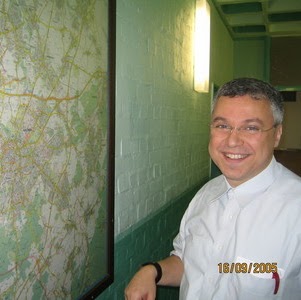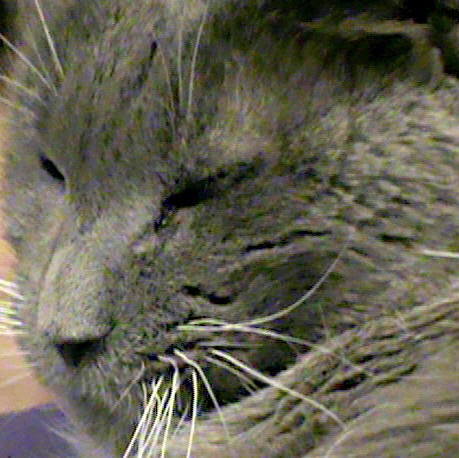James H Samuels
age ~66
from Hillside, NJ
- Also known as:
-
- James H Samuelsjr
- James H Samuel
James Samuels Phones & Addresses
- Hillside, NJ
- 180 Huntington Ter, Newark, NJ 07112
- 180 Huntington Ter FL 2, Newark, NJ 07112
- 18 Yates Ave, Newark, NJ 07112
- 95 Schuyler Ave, Newark, NJ 07112
- Littleton, NC
- Roselle, NJ
- Union, NJ
Work
-
Company:Family & consulting services2008
-
Position:Counselor/therapist (part-time)
Education
-
School / High School:NEW YORK THEOLOGICAL SEMINARY- New York, NY1991
-
Specialities:Master of Professional in MPS
Us Patents
-
Dynamic Determination Of Moire Interference On A Crt Display With Correction Selectively Applicable To Sections Of Lines
view source -
US Patent:6348903, Feb 19, 2002
-
Filed:Mar 18, 1999
-
Appl. No.:09/271999
-
Inventors:Chin Tao Wu - New Brunswick NJ
James Vincent Samuels - Monmouth Junction NJ -
Assignee:MultiVideo Labs, Inc. - Princeton NJ
-
International Classification:G09G 106
-
US Classification:345 10, 3152821, 348806, 358533
-
Abstract:Lines or sections of lines on a scanned CRT display are checked to determine whether a moire pattern exists. The existence is determined by comparing the number of pixels occurring on a line or a section of a line to a reference count corresponding to a moire pattern. Substantial equality of the pixel count and the reference count enables a moire correction circuit for the section of the display containing the moire pattern. In sections of the display where the moire pattern does not occur, i. e. , the pixel count and the reference count are not substantially equal, the moire correction circuit is automatically disabled.
-
Universal Serial Bus Repeater
view source -
US Patent:6363085, Mar 26, 2002
-
Filed:Mar 23, 1998
-
Appl. No.:09/046442
-
Inventors:James Vincent Samuels - Monmouth Junction NJ
-
Assignee:MultiVideo Labs, Inc. - Princeton NJ
-
International Classification:H04L 1250
-
US Classification:370502, 370252, 370242
-
Abstract:Universal Serial Bus active extension cable for increasing the distance between devices coupled via a Universal Serial Bus cable includes a pair of transceivers for bidirectional transmission of data therealong. A drive detector senses which terminal device is transmitting data and enables the other terminal device to receive the data. A speed detector senses which of more than one transmission speed is being used and sets the devices coupled to the cable accordingly. An end-of-packet detection determines when the transmission of a packet of data has been completed. When the system enters a suspend mode, a detector sets the components to a low power mode.
-
Analog To Digital Video Adapter
view source -
US Patent:47362405, Apr 5, 1988
-
Filed:Apr 28, 1986
-
Appl. No.:6/856660
-
Inventors:James V. Samuels - Monmouth Junction NJ
-
International Classification:H04N 964
-
US Classification:358 21R
-
Abstract:The invention processes a National Television System Committee (NTSC) standard video signal to allow a digital, transistor to transistor logic (TTL), 8 color, separate red, green, and blue (RGB) video, color monitor to be used to display television (TV) images. The infinite colors necessary for TV are produced on an 8 color TTL monitor through pulse width modulation. Thus, the width of the TTL video pulse to each color input of the monitor is proportional to the brightness required that is contained in the NTSC signal.
-
Video Display Adjustment And On-Screen Menu System
view source -
US Patent:52708217, Dec 14, 1993
-
Filed:Nov 22, 1991
-
Appl. No.:7/796411
-
Inventors:James V. Samuels - Monmouth Junction NJ
-
Assignee:Acer Incorporated - Taipei
-
International Classification:H04N 544
-
US Classification:358188
-
Abstract:An EEPROM stores multiple sets of video display parameters for a multi-frequency video display. A microcontroller receives input from a user, changes the stored display parameters and outputs changes in the parameters to the video display. The microcontroller also controls video display apparatus that displays on-screen menus and value indicator graphs for facilitating user input. The video display apparatus incorporates a video clock synchronized to the horizontal synchronization signal of the multi-frequency display, to keep the displayed menus synchronized regardless of the current frequency. In addition, the video display apparatus elongates displayed characters at higher frequencies to control the absolute size of displayed characters across frequencies. The present invention provides for changes to video display parameters, and for resetting the display parameters to factory standards, without manipulating electromechanical devices such as potentiometers.
-
Transmitting Data And Commands To Display Monitors
view source -
US Patent:55505562, Aug 27, 1996
-
Filed:Nov 1, 1993
-
Appl. No.:8/145864
-
Inventors:Chin T. Wu - No. Brunswick NJ
James V. Samuels - Monmouth Junction NJ -
Assignee:MultiVideo Labs, Inc. - Princeton NJ
-
International Classification:H04N 504
H04N 708 -
US Classification:345 14
-
Abstract:Transmitting via color signals or vertical signals to control a computer's display monitor using software adjustments of the display parameters. A user can vary the display parameters including, for example, the contrast, brightness, horizontal and vertical size and position, inter alia, and transmit other commands and other data using codes transmitted with the color codes, or alternatively, with the vertical synchronization pulses.
Resumes

James Samuels
view source
James Samuels
view source
James Samuels
view source
James Samuels
view source
James Samuels
view source
James Samuels
view source
James Samuels
view sourceLocation:
United States
Name / Title
Company / Classification
Phones & Addresses
Chairman of the Board
WORK 2XL CORP
Nonclassifiable Establishments
Nonclassifiable Establishments
2171 Madison Ave 3C, New York, NY 10037
2171 Madison Ave, New York, NY 10037
2171 Madison Ave, New York, NY 10037
3326 BROADVIEW, LTD
POST DELIVERY SYSTEMS LTD
JASNAZ DEVELOPMENT COMPANY, LLC
GRANDFIELD & DODD LLC
Management Consulting Services
Management Consulting Services
40 Wall St SUITE 4700, New York, NY 10005
17 Battery Pl, New York, NY 10004
(212)4779626
17 Battery Pl, New York, NY 10004
(212)4779626
Security Administrator
New York City Health and Hospitals Corporation
General Hospital Specialty Hospital Specialty Outpatient Clinic · Specialty Outpatient Clinics Nec
General Hospital Specialty Hospital Specialty Outpatient Clinic · Specialty Outpatient Clinics Nec
125 Worth St, New York, NY 10013
93 Worth St, New York, NY 10013
(212)7883321, (718)5108538
93 Worth St, New York, NY 10013
(212)7883321, (718)5108538
ENTERTAINMENT & CINEMA CONCEPTS, INC
Principal
Mayors Councl Against Poverty
Individual/Family Services · Nonclassifiable Establishments
Individual/Family Services · Nonclassifiable Establishments
100 Church St, New York, NY 10007
(212)5665710
(212)5665710
Classmates

James Samuels
view sourceSchools:
University Preparatory School Laramie WY 1959-1963
Community:
Hunter Patrick, Merridy Allen, Jan Orth, Marsha Turner, Kathleen Rogers

James Samuels
view sourceSchools:
Henry County High School Paris TN 1999-2003
Community:
Cammie Clayton

James Samuels
view sourceSchools:
McKinney Boyd High School Mckinney TX 1957-1961
Community:
Alan Farley, Rob Ites, Linda Newby, Billy Tarvin

James Samuels
view sourceSchools:
Matsu Alternative High School Wasilla AK 1985-1989
Community:
Terri Trask, Desiray Silva, Christina Lacher, Samantha Rodekohr

James Samuels
view sourceSchools:
St. Nicholas of Tolentine High School Bronx NY 1979-1983
Community:
Helen Doyle, Dorothy Scerri, Edania Hernandez, Rose Ricciardella, Bob Lancellotti

James Samuels
view sourceSchools:
Clinton Central High School Clinton NY 1969-1973
Community:
Diane Larsen

James Samuels
view sourceSchools:
West Forsyth High School Clemmons NC 1973-1977
Community:
David Hudson, Lisa Binkley, Lorie Thompson, David Heiser, Annette Lynn, Vernon Brown, Laura Hall, Greg Simpson, Tina Lemon, Kara Brooks, Mary Cea

James Samuels Jr., West S...
view source
James Samuels
view source
James Samuels
view source
James Samuels
view source
James Clarence Samuels Jr.
view source
James Samuels
view source
James Jeremiah Samuels
view source
James Jeremiah Samuels
view source
James Krim Samuels
view sourceMyspace

James Samuels
view sourceLocality:
TRE-4 WHERE THE REAL G BE, North Carolina
Gender:
Male
Birthday:
1950
Googleplus

James Samuels

James Samuels

James Samuels

James Samuels

James Samuels

James Samuels

James Samuels

James Samuels
Youtube
Get Report for James H Samuels from Hillside, NJ, age ~66









